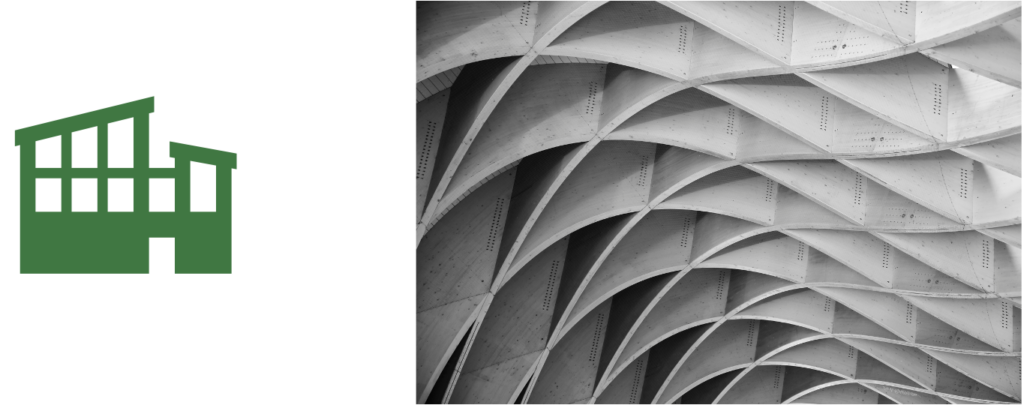
The following group of blogs develops the history of materials and structures and reveals how nature could give as thorough insights on how to manufacture products for the coming decades. Every industry should transition towards sustainability in order to tackle complex issues such as climate change, pollution and soil erosion among others if we wish to preserve our planet.
1. Our legacy
How we might construct the future in the coming decades? Which are the resources that will makes us transition towards sustainability? While we stroll through this winding road, there is one sign that might open an almost infinite source of possibilities: The way nature construct their structures. From microscopic bacteria to sequoia tress or blue whales in the ocean, organisms has evolved a diverse palette of patterns that can be followed if we wish to move away from mainstream processes that produce most of our built environment’s building blocks , such as concrete , plastics or fossil fuels. But before we dive into how nature create their structures it is relevant to review what we have done so far in terms of structures and materials.
Simple crafts that were first developed by mankind at least 2.5 million years B.C. where materials like obsidian, bone and wood were employed to build structures such as households and utensils for hunting and cooking. Around the period between 1.7-2.0 million years fire was discovered , becoming one of the greatest events in our history and allowing the development of different areas , including material’s science. History unfolds into the copper age where metals such as gold began to appear seldom in some luxury artefacts that were devoted to ruling classes. During this period (12.000-3.000 B.C.) ceramics such as pottery or glass and polymers (fibers mainly) were employed for different activities in society. However, the use of high temperatures and pressure for developing some materials would had to wait until later ages. Also, the acknowledgement of the structures that make up manufactures was impossible to obtain. Thereafter, the bronze age (3.000-1.200 BC) brought polymers such as glue and composite materials (made up of the combination of two among metals , ceramics or polymers) such as brick and paper, besides a small increase of use of metals such as iron and copper, allowing armies to employ them for their weapons and conquer territories. It was followed by the iron age (1.200 B.C- 300 A.D.) where steel, new type of glasses and processed minerals where the norm. Progressively, the use of metals and alloys where getting pace. During the middle ages, for example, porcelain ceramics included metal incrustations and refractory ceramics where employed to build them. The industrial era that extends from 1.300 to 1.950 A.D. witnessed the biggest explosion of different type of materials:
• Metals: Alloy steels, light alloys , aluminum, titanium and zirconium amongst others were implemented, mostly during the industrial revolution, allowing the urbanization of the modern era.
• Polymers: Rubber, bakelite and nylon were used for different purposes in industries and every day activities.
• Ceramics: Refractory bricks, Portland cement and fused silica where significant in the construction of the modern built environment.
During this era, material’s scientists were capable of looking at the underlying structures of different materials and begin to manipulate them for improving their performance. The silicon age or the “Information Era” brought all this knowledge together to create advanced composite materials and polymers such as polyesters and epoxies.
We have crossed materials and built structure’s history as a high speed satellite over earth. Of course, there are amazing stories about how we were able to craft tall buildings, airplanes, mobile phones and so on. And there are also some guiding rules that allowed our technology to come this far, independent if those decisions were judgmentally right or wrong. First, higher pressures and temperatures have been used progressively produce high performance materials , thus increasing the energy employed to produce structures. Second, we have used of a large swath of elements of the periodic table , some of which are scarce or difficult to source using harsh practices such as mining. Third, we have had the wrong belief that all resources are unlimited and manufactures are employed for single use. Fourth, our designed structures have been created rigid and do not often change over time. Fifth, our structures lack capacity of self-healing or renewal currently. Finally our composite materials have seldom more than three building block, hence with reduced diversity as can be seen in figure 1.
Therefore, the present and coming decades will push our knowledge’s fringes for transformation and innovation in the way we build our structures towards sustainability. And it is the strong belief of Greenroad ® that biomimicry is one of the paths that could lead to that end. In the next chapter the principles through which structures in nature are built as well as the materials it employs.

Figure 1: Relative importance of materials through human history. Taken from Shah,D (2013)
References
Shah,D(2013).Characterisation and optimisation of the mechanical performance of plant fibre composites for structural application. PhD University of Nottinghham.

